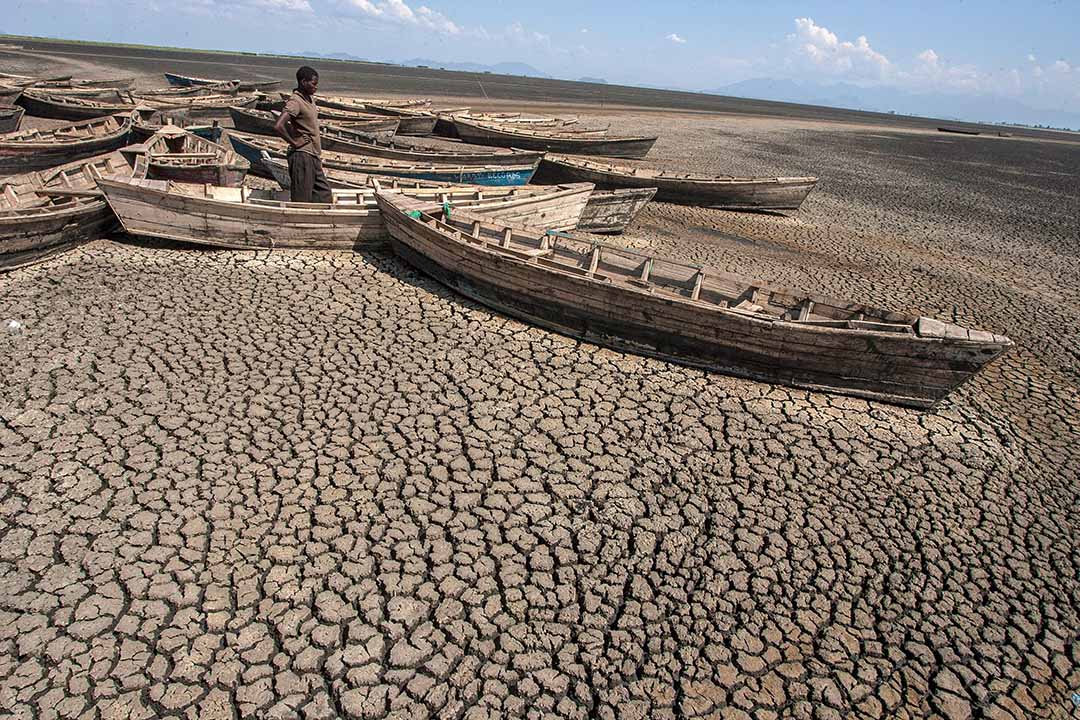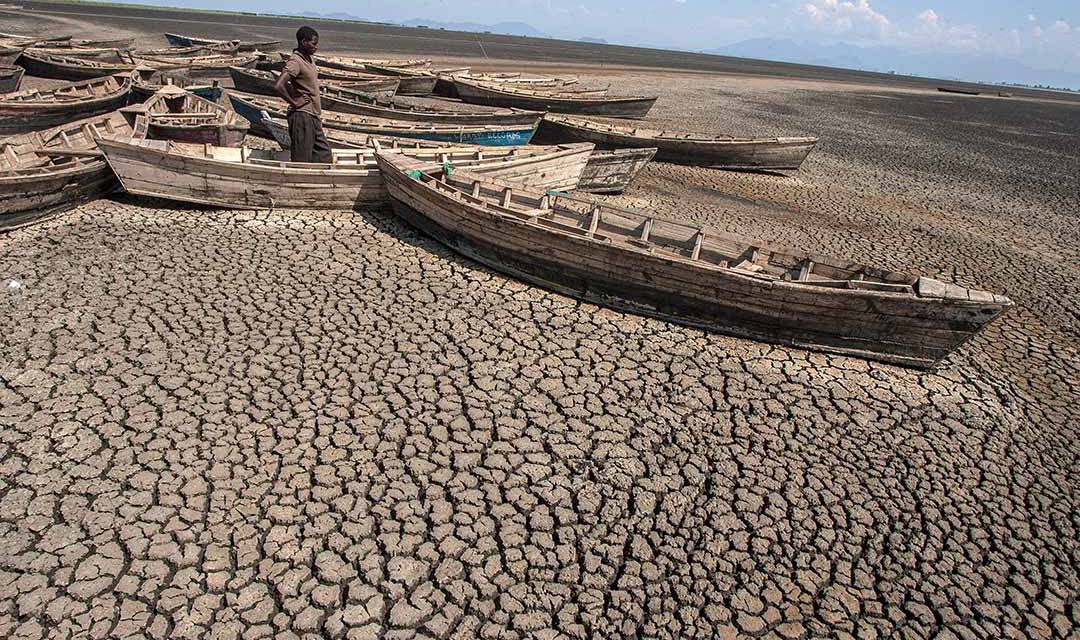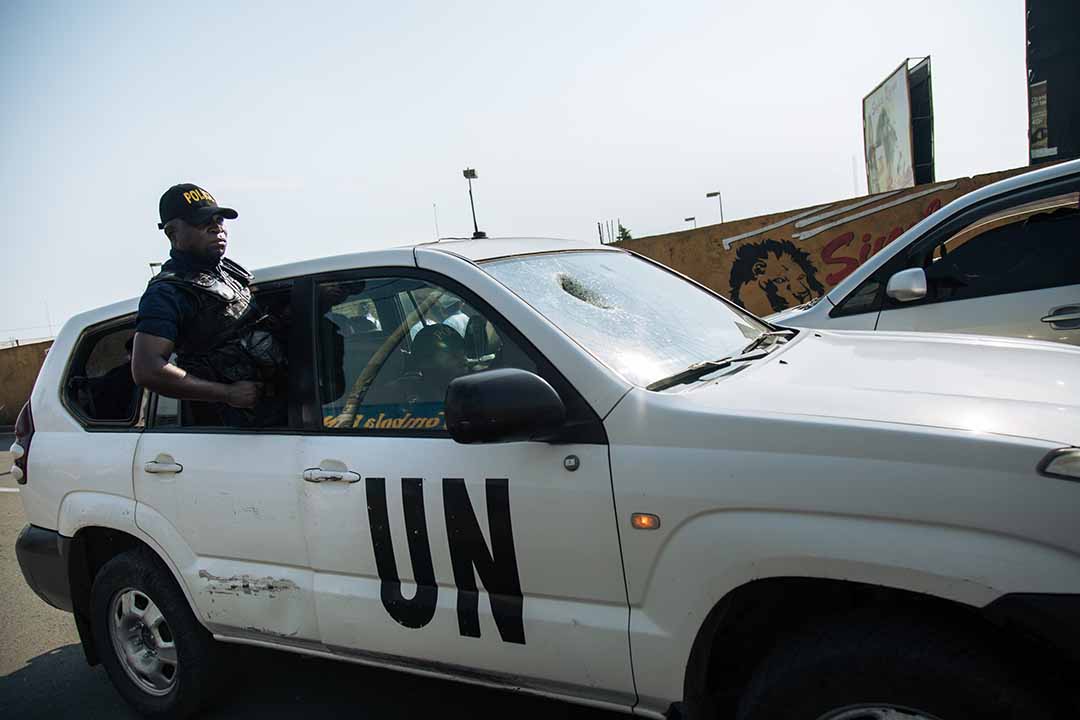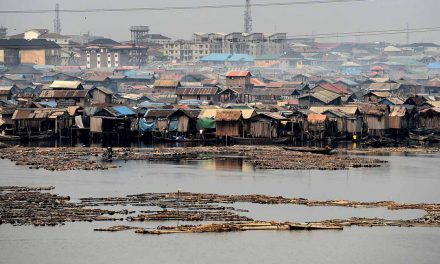Climate change will hit Africa hard, but it also offers the continent an opportunity to build resilience and diversify livelihoods.
The changes ahead for Africa’s environment, which form the foundation of the continent’s societies and economies, will be challenging, but bright spots abound. Africa has contrasting environments absent a singular definition. A mosaic of terrains, the continent weaves together tropical forests, grasslands, savannahs, deserts and mangroves, ice-capped mountains, rivers, lakes and coasts across 55 countries, 1.2 billion people and 30 million square kilometres of land. This enormous landmass contains a quarter of global biodiversity, supports the world’s most prodigious gatherings of large mammals, and its diverse animal, plant and marine ecosystems drive economies and shape societies, cultures and development.

A young man stands among stationary boats at the dried inland Lake Chilwa in Zomba District, eastern Malawi, October 2018. Lake Chilwa is the second-largest lake in Malawi after Lake Malawi. The dying lake is having an adverse effect on the livelihoods of communities. Photo: Amos Gumulira/AFP
Human actions have played a central role in changing the African environment and its landscape over a long and complex history. African indigenous knowledge and practices include shared cropping systems and rain-fed irrigation methods that have mitigated droughts and famine for centuries. Yet, much of the more recent environmental history of Africa is dominated not by stories of Africans managing a challenging environment in harmony with ecosystems, but rather of foreign-driven exploitation of its people and resources, including minerals, fossil fuels, farm and forest produce for export.
Africa today is no less dependent on its environment than in the past. This is especially true in rural areas. Approximately 57% of Africa’s population, or 740 million people, live in rural areas. Agriculture is the continent’s biggest employer, supporting the livelihoods of 51% of the population. The majority of the population working in agriculture is engaged in smallholder agriculture that is undertaken in harsh environmental conditions with limited and highly variable natural rainfall. The high dependence on agriculture and the environment has significant and far-reaching consequences, not just for the 740 million rural people of Africa, but for the continent as a whole.
The United Nations Food and Agricultural Organization (FAO) reports that nearly a quarter of the population, or 224 million people, in sub-Saharan Africa are undernourished, with 31% experiencing food insecurity. Food shortages and malnutrition result in stunted growth and permanent damage that has long-term impacts. On a continental level, Africa is not feeding itself. According to the African Development Bank, net food imports to Africa are costing on average $35-$42 billion per year and are predicted to reach $110 billion by 2025. As stated by Akinwumi Adesina, the bank’s president, in 2017, “Africa’s annual food import bill weakens African economies, decimates its agriculture and exports jobs from the continent.” This food bill does not represent investment – these are sunk costs.
The consequence of this heavy reliance on challenging and unpredictable environmental conditions by such a large proportion of the population is a significant downward pressure on human and economic development. With two thirds of every country’s human capital beholden to the environment, and more specifically unpredictable rainfall to provide livelihoods, the opportunities for entry into skilled employment such as teaching, business, the health profession and trading are curtailed.
Climate change is making these challenges worse. The facts and figures on global climate change are startling. Prior to 1800, the global level of atmospheric CO2 was 280 parts per million (ppm).
Data drawn from ice cores show that CO2 varied within a relatively narrow range, roughly between 180 and 280 ppm, over the past 800,000 years – never moving above 300 ppm. Currently, CO2 is above 416 ppm. Over this same 800,000 years, methane has never been higher than 750 parts per billion (ppb), but now this gas, which is 22 times more powerful than CO2, is 1,873 ppb. The unprecedented speed and scale of these greenhouse gas emissions brings us into a new era of uncertainty with regards to their impact on the environment and our planet. According to the UN, Africa is the continent that will be hardest hit by climate change.
The key word, however, when attempting to understand climate change in Africa, is uncertainty. One of the challenges in predicting the impact of climate change on the continent is the extremely complex, yet poorly understood, large-scale weather systems that interact across the landscape. While rainfall patterns have been exceptionally difficult to predict, the Intergovernmental Panel on Climate Change (IPCC) states that temperatures have risen by about 0.5°C over most of the African continent during the past 50-100 years. While this increase in temperature may seem insignificant, it is accelerating and will have a widespread impact on agriculture.
Many staple crops such as wheat, maize, millet and sorghum are especially susceptible to changes in temperature. Scientists predict that by 2050 the agricultural production of millet and sorghum in West Africa will potentially decrease by 13% in Burkina Faso, 25.9% in Mali and 44.7% in Senegal. Even if a quarter of these decreases in production are actualised, they will amplify shocks and stresses in those countries that today face food insecurity that will have an impact on up to five million people, according to the World Food Programme. Higher temperatures will also likely cause desert areas to encroach further south, also limiting agricultural options.
This may have unexpected consequences on migration and food insecurity, forcing people into conflict and causing an increase in bush meat consumption that may encourage new zoonotic diseases to emerge. Climate change will further impact biodiversity. An assessment report on biodiversity and ecosystem services for Africa, published by the independent Intergovernmental Science-Policy Platform on Biodiversity and Ecosystem Services (IPBES), estimates that by 2100 climate change could have caused the loss of over half of Africa’s bird and mammal species and a significant loss of plant species.
That will have a substantial impact on livelihoods, water and food supply and reduce people’s resilience to shocks and stresses because these ecosystems are the foundation of healthy societies and economies. Another area of clear impact occurring along coasts due to rising sea levels and warming. Sea levels have risen between 13-20 cm over the past 100 years and this is accelerating. Rising sea levels are caused by warming seas that expand as they increase in temperature and melting land-based ice flows into the ocean. Africa has just over 30,000 km of coastline that is undergoing increasing population growth and urbanisation.
These urban areas will be susceptible to more flooding due to storm surges. But warming sea levels are also impacting the environment in other, unpredictable ways. The devastating locust swarms currently destroying crops and livelihoods across East Africa may be linked to climate change. The warming Indian Ocean has contributed to 2019 being one of the wettest October-December rainy seasons in five decades. This drove eight cyclones across the region in 2019 – the most since records began – and enabled desert locusts to leapfrog into East Africa where they have now laid eggs and are hatching in their trillions.
David Hughes of the UN’s FAO, told the BBC in May that they “threaten the food of 23 million people. It is the number one food security issue in East Africa at the moment.” Climate change is not the only factor leading to this uncertain future, however. Many scientists posit that we have now entered the Anthropocene, a new geological age in which human activity has been the dominant influence on climate and the environment. The African environment, for example, has suffered significantly from human-led degradation that has accelerated over the past century. This includes the over-exploitation of wildlife and fisheries and natural habitat loss, especially from agricultural expansion.
The Anthropocene is characterised by an increasingly interconnected and accelerating world. These characteristics have significant implications for how we understand risks. The current Covid-19 pandemic is an example of how a zoonotic disease that emerged from wildlife to humans in a city in China is having an enormous and rapid negative impact on people and economies in Africa and around the globe. When we combine the interconnected and rapidly changing nature of the Anthropocene with the uncertain impacts of climate change in the context of Africa, the future looks challenging.
African leaders are not to blame for the impacts of climate change against which they must build resilience. Africa has 17% of the world’s population, but has only contributed 4% to global carbon emissions, and much of this has been to supply export products for higher-income countries. But regardless of where the blame for climate change lies, the reality is that the global public and private sectors have a shared responsibility to address the interconnected and uncertain risks it poses.
Domestically, African governments and the private sector need to recognise the impact of climate change and champion green growth that works with nature to build resilience and supports people, especially rural populations, to adapt through improved early warning systems, agricultural investment and diversified livelihood options. The current Covid-19 pandemic and its economic implications provide an opportunity to employ the old adage of “never waste a crisis”. As Paul Kagame, the President of Rwanda stated: “We are not making a choice between environment and prosperity; but we are rather looking at how we combine both.”
This is the opportunity to invest in recovery solutions, such as job programmes that directly invest in natural capital like nature-based tourism, that will help the continent to come back stronger. The World Travel and Tourism Council estimates, for example, that 3.6 million people in Africa are employed in the nature-based tourism industry, which was worth $29 billion in 2018. These programmes can also build the capacity of local communities and drive forward opportunities for women and youth.
Navigating this uncertain future will also require an improved understanding of environmental and human interactions through investing in science and education.
For Africa to thrive amidst the shocks and stresses that lie ahead, it will need leadership and cooperation from governments, the private sector and people that builds resilience to upcoming challenges by supporting growth and development that protects and works with the environment. As South African climate activist Ndivile Mokoena said: “Climate change is largely viewed as an environmental issue. However, it encompasses everything: it is a developmental issue, it is a human rights issue, it is a social issue.”
Dr Nathanial Matthews is a political and environmental scientist whose principal interests lie in understanding and mitigating the impacts of political and economic change on people and the environment in developing countries. He has 15+ years of professional and fieldwork experience spanning 30 countries around the globe, primarily focused in Asia and Africa.
Nate is currently the Program Director of the Global Resilience Partnership (GRP). In this role, he is responsible for defining and executing the overall strategy related to GRP’s technical work streams and leading the teams implementing these streams including markets and innovative financing, technology and infrastructure, and policy and influence.
Previously to this role, Nate was Global Research Coordinator and Flagship Leader of the US$36 million Integrating Ecosystems into Policy and Solutions Flagship for the Consultative Group on International Agricultural Research (CGIAR) programme on water, land and ecosystems (WLE).
Nate has published two books and over 40 peer-reviewed publications covering environmental justice, forestry, agriculture, irrigation, hydropower, ecosystems services, resilience and the water-energy-food nexus. He has given dozens of senior-level international talks.













